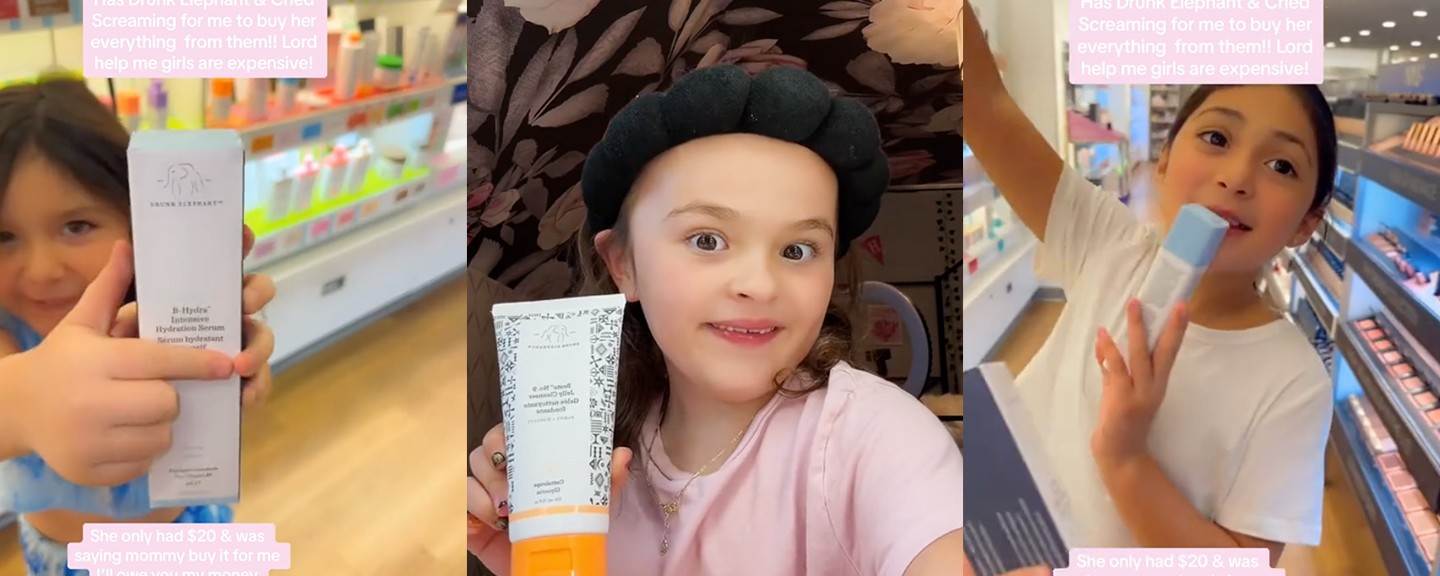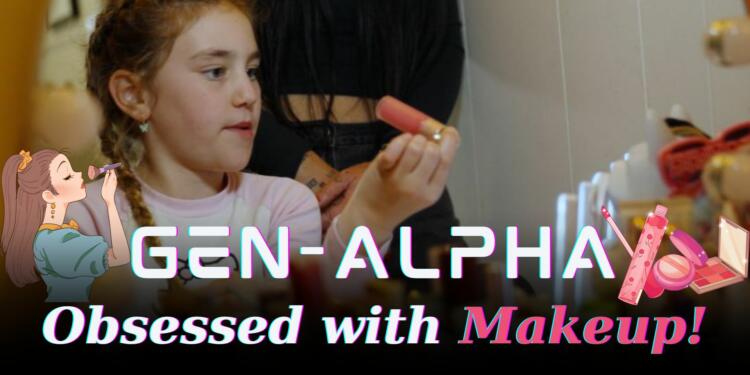The burgeoning trend of “Sephora Kids” underscores a remarkable shift in consumer behavior among tweens, driven by the omnipresence of social media. With hashtags like #sephora and #sephorakids dominating platforms like TikTok and Instagram, young consumers are increasingly drawn to cosmetic stores, eager to explore skincare products typically marketed to adults. Videos shared online showcase children as active participants in selecting and applying these products, mirroring the beauty routines of influencers. This phenomenon highlights the profound influence of social media on youth culture and raises questions about the implications of early engagement with skincare products among tweens.
The Phenomenon of ‘Sephora Kids’
The emergence of the ‘Sephora Kids’ phenomenon has taken social media by storm, particularly on platforms like TikTok and Instagram. This trend showcases a growing fascination among young children and teenagers with skincare products typically associated with adult consumers. Videos tagged with hashtags like #sephora or #sephorakids depict children eagerly exploring Sephora stores, excitedly selecting and applying various skincare items, and sharing their extensive beauty routines with online audiences.
The popularity of these videos underscores the significant influence of social media in shaping consumer behaviors and preferences, even among younger demographics. The allure of ‘Sephora Kids’ content lies in its novelty and aspirational appeal, as children emulate the skincare routines of adult influencers and celebrities showcased on their favorite platforms.
A notable aspect of this trend is the active involvement of young children in the selection and usage of skincare products. In videos shared online, children as young as four years old are seen accompanying their parents to Sephora, enthusiastically browsing through shelves filled with serums, toners, and other cosmetic items. Some influencers, like the seven-year-old twins Koti and Haven with millions of followers on TikTok, have gained prominence for their ‘Get-Ready-With-Me’ videos, featuring elaborate skincare rituals.
However, alongside the buzz surrounding ‘Sephora Kids’ content, concerns have been raised by both retailers and consumers regarding the behavior of young shoppers in cosmetic stores. Complaints have surfaced regarding instances of children exhibiting disruptive behavior, such as grabbing products from other shoppers’ hands, creating messes in-store, and tampering with display items. Retailers and consumers alike have expressed frustration over the perceived lack of supervision and discipline among young shoppers, leading to disruptions in the shopping experience for other customers.
Also Read: AI’s Multiverse Dilemma: Government Steps In with Advisory
Expert Opinions and Concerns
Dermatological Insights
Dermatologists express apprehension regarding the potential risks associated with tweens using skincare products designed for adults. Lead dermatologist Dr. Renita Ahluwalia of the Canadian Dermatology and Plastic Surgery Centre in Toronto warns against the use of ingredients like retinol, exfoliating acids, and fragrances, which may be unsuitable for children’s delicate skin. She highlights the risk of irritation, breakdown of the skin barrier, and the development of dermatitis and acne, particularly when tweens engage in extensive skincare routines involving multiple products.

Adverse Effects of Ingredients
The adverse effects of certain ingredients on children’s skin underscore the importance of age-appropriate skincare routines. Dr. Ahluwalia emphasizes that children’s skin differs from that of adults and requires gentle, non-irritating formulations tailored to their specific needs. Exposing young skin to harsh or unsuitable ingredients may exacerbate existing skin issues and compromise its natural barrier function, leading to long-term damage and discomfort.
Financial Implications for Parents
As children develop expensive skincare habits influenced by social media trends, parents face significant financial implications. The allure of ‘Sephora Kids’ content and the desire to emulate celebrity-endorsed beauty routines may drive children to request costly skincare products, putting strain on family budgets. Dr. Ahluwalia cautions against the emergence of a “pricey habit” among parents who feel pressured to purchase these products to satisfy their children’s desires. Moreover, the proliferation of skincare brands targeting tweens contributes to increased spending on beauty products tailored to younger demographics, further exacerbating the financial burden on families.
Also Read: Headache Chronicles: The Dark Corners of the Hidden Pandemic
The Generation Alpha
Strategies for Young Consumers
Beauty brands are increasingly focusing on catering to younger consumers, including the introduction of skincare and makeup lines specifically designed for children. Companies like Yawn and Bubble have launched skincare and makeup products tailored to clients as young as three years old, tapping into the burgeoning demand for age-appropriate beauty solutions among Generation Alpha. These products often feature gentle formulations, vibrant packaging, and playful branding to appeal to children’s preferences and sensibilities.
Marketing Tactics for Tweens
To appeal to tweens, beauty brands leverage a variety of marketing tactics, with a particular emphasis on social media influencers and age-specific products. Influencers with large followings among younger demographics are often enlisted to endorse products and create engaging content that resonates with tweens. Brands utilize platforms like TikTok and Instagram to showcase trendy beauty routines, offer tutorials, and foster a sense of community among young consumers. Additionally, they develop age-specific product lines targeting tweens, incorporating features and ingredients tailored to their skincare needs and preferences.
Growth of the Baby and Child Skincare Market
The baby and child skincare market has experienced significant growth in recent years, driven by increasing awareness of skincare among parents and the growing influence of social media on consumer preferences. According to Statista data, the market is projected to reach a global volume of approximately $380 million by 2028, with an annual growth rate of roughly 7.71%. This growth is fueled by factors such as rising disposable incomes, changing perceptions of skincare as a form of self-care, and the proliferation of specialized beauty brands catering to younger demographics. As Generation Alpha continues to shape consumer trends, the baby and child skincare market is poised for further expansion, presenting lucrative opportunities for beauty brands to innovate and capitalize on evolving consumer preferences.
Also Read: Facts or Fiction: The Economist’s Whimsical Take on India’s Economic Divide
Impact of Social Media and Retail
Social media plays a pivotal role in shaping tween preferences and behaviors, especially in the realm of beauty and skincare. The isolation experienced during the pandemic has led to increased screen time among tweens, providing ample opportunities for exposure to beauty trends and influencers on platforms like TikTok, Instagram, and YouTube. Through curated content and relatable influencers, social media platforms create an aspirational environment where tweens seek validation and identity through beauty routines and products.

Influence of Social Media Algorithms
Social media algorithms further amplify the influence of beauty influencers on tween consumption patterns. These algorithms prioritize content that aligns with users’ interests and behaviors, creating echo chambers where beauty trends and recommendations are continuously reinforced. As tweens engage with beauty-related content, algorithms tailor their feeds to showcase similar content, perpetuating cycles of consumption and aspiration. This algorithmic feedback loop not only drives engagement but also shapes tweens’ perceptions of beauty norms and product preferences.
Retail Store Normalization and Promotion
Retail stores play a crucial role in normalizing and promoting tween skincare products on their shelves. By strategically positioning products in high-traffic areas and leveraging attractive displays, retailers capture the attention of young consumers and encourage impulse purchases. In-store experiences, such as makeup demonstrations and interactive displays, provide opportunities for tweens to explore and experiment with skincare products, fostering brand loyalty and repeat purchases. Additionally, collaborations between retailers and beauty brands, as well as exclusive product launches, generate excitement and drive foot traffic, further solidifying the presence of tween skincare products in retail spaces.
Also Read: From Dollars to Rupees: India’s Game-Changing Currency Conundrum
Psychological Implications and Cultural Context
Tweens’ obsession with personal appearance and self-identity stems from a complex interplay of psychological factors. As they navigate the transition from childhood to adolescence, tweens grapple with the development of self-concept and social identity. Heightened awareness of physical appearance arises from a desire for social acceptance and belonging, as tweens seek validation and recognition from peers and societal norms. Additionally, exposure to idealized beauty standards through media and social platforms fosters comparison and self-evaluation, driving a quest for conformity and validation through appearance-related behaviors such as skincare routines.
Historical Context of Tween Sensitivity to Appearance
Tween sensitivity to appearance has historical roots intertwined with shifting cultural norms and beauty standards. Throughout history, adolescence has been recognized as a pivotal stage marked by physical and psychological changes, leading to heightened self-consciousness and identity formation. With the advent of mass media and advertising in the 20th century, beauty ideals became increasingly pervasive, influencing tween perceptions of attractiveness and desirability. Today, the ubiquity of digital media exacerbates these trends, presenting an idealized and often unattainable standard of beauty that shapes tween attitudes towards self-image and appearance.
Societal Pressures and Skincare Routines
Tweens face a myriad of societal pressures that contribute to the significance of skincare routines in shaping their self-perception. In an era dominated by social media and digital communication, tweens are inundated with curated images and narratives that promote beauty and perfection. The pressure to conform to these standards fosters a sense of insecurity and inadequacy, leading tweens to seek solace and empowerment through skincare rituals. Skincare routines offer a semblance of control and self-care amidst turbulent developmental changes, serving as a means of self-expression and identity construction in a visually-oriented culture.
In conclusion, the ‘Sephora Kids’ trend reflects a complex interplay of social media influence, retail dynamics, and tween psychology. While it offers opportunities for self-expression and empowerment, it also poses risks such as exposure to unsuitable skincare products and financial burdens on families. There is a crucial need for further research and awareness to promote age-appropriate skincare practices for children. Responsible marketing practices and parental guidance are essential to safeguard the well-being of tweens amidst evolving beauty trends.
Also Read: What is Samsung Ballie? or Is it Who!































